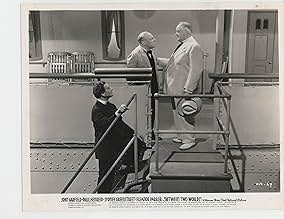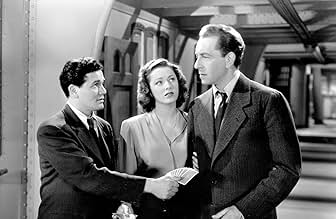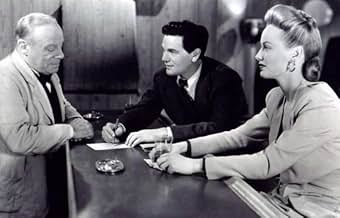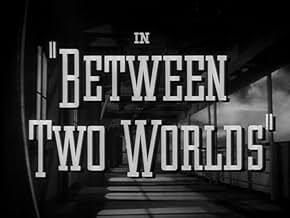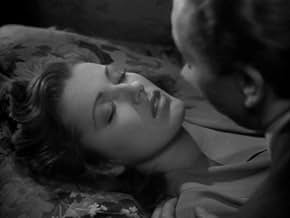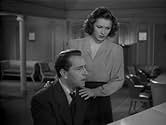ÉVALUATION IMDb
7,1/10
2,6 k
MA NOTE
Les passagers d'un paquebot ne peuvent pas se rappeler comment ils sont montés à bord ni où ils vont, mais curieusement, il devient vite évident qu'ils ont tous quelque chose en commun.Les passagers d'un paquebot ne peuvent pas se rappeler comment ils sont montés à bord ni où ils vont, mais curieusement, il devient vite évident qu'ils ont tous quelque chose en commun.Les passagers d'un paquebot ne peuvent pas se rappeler comment ils sont montés à bord ni où ils vont, mais curieusement, il devient vite évident qu'ils ont tous quelque chose en commun.
- Director
- Writers
- Stars
- Prix
- 4 victoires au total
Sami Ayanoglu
- Davis
- (uncredited)
Lester Matthews
- Steamship Dispatcher
- (uncredited)
Patrick O'Moore
- Steamship Clerk
- (uncredited)
Avis en vedette
This is a remake of the 1930 early-talkie "Outward Bound", which was based on the hit 1925 stage play. This version updates the period from the 1920's to the 1940's, and incorporates WW II elements into the story---a totally unnecessary tactic; the original play was quite good on its own and didn't need to have topical elements awkwardly sandwiched in. In fact,one of its strengths was that the entire unworldly experience seemed to take place in an unspecified time.
But this film has a very realistic beginning to it, and a war-related incident sets the plot in motion. The film's only serious blunder---though one that does not fatally affect it----is that we are tipped off as to what is really going on much too early in the film, in comparison to the 1930 film version, in which the characters realized their true situation at the same time as the audience did.
Aside from those objections, though, this is one of the few remakes which tops the original in nearly every department. Without exception, the actors in this version outdo the stiff, primitive early-talkie performances of their predecessors, and this may well be the only film in which Paul Henreid, normally not the most charismatic actor, gives a finer performance than the then-awkward Douglas Fairbanks,Jr. did in the same role in the 1930 film.
Especially outstanding are Edmund Gwenn as the ship's steward, Isobel Elsom as a rich, elderly, bitchy woman, Sydney Greenstreet as a mysterious character whose identity will not be revealed here, and Sara Allgood in one of the most sensitive performances of her career (she acts rings around Beryl Mercer from the 1930 version). George Coulouris, a reliable villain in those days (he was Orson Welles' nasty guardian in "Citizen Kane") is sinister and pompous as a greedy tycoon. And John Garfield is excellent in the Leslie Howard role, altered some to fit Garfield's tough, bitter on-screen persona rather than Howard's ultra-sophisticated, debonair one. (Garfield,though,does not go as berserk when he finds out the truth as Howard so hilariously did in the 1930 version.)
Although much of the dialogue in the first half has been changed and perhaps made slightly less "literary", the second half,which features Sydney Greensteet, is quite faithful to the earlier film and the stage play. Erich Wolfgang Korngold's music runs through nearly every scene, and, although verging toward the bombastic and melodramatic at times, lends plenty of atmosphere to the story.
One unfortunate aspect is that the photography in this version never becomes as eerie as that in the 1930 version, with its striking light and darkness effects. But none of these faults should keep you away from this film, which deserves far better than its relative obscurity in comparison to the other great Warner Bros. classics as well as other films dealing with the afterlife.
But this film has a very realistic beginning to it, and a war-related incident sets the plot in motion. The film's only serious blunder---though one that does not fatally affect it----is that we are tipped off as to what is really going on much too early in the film, in comparison to the 1930 film version, in which the characters realized their true situation at the same time as the audience did.
Aside from those objections, though, this is one of the few remakes which tops the original in nearly every department. Without exception, the actors in this version outdo the stiff, primitive early-talkie performances of their predecessors, and this may well be the only film in which Paul Henreid, normally not the most charismatic actor, gives a finer performance than the then-awkward Douglas Fairbanks,Jr. did in the same role in the 1930 film.
Especially outstanding are Edmund Gwenn as the ship's steward, Isobel Elsom as a rich, elderly, bitchy woman, Sydney Greenstreet as a mysterious character whose identity will not be revealed here, and Sara Allgood in one of the most sensitive performances of her career (she acts rings around Beryl Mercer from the 1930 version). George Coulouris, a reliable villain in those days (he was Orson Welles' nasty guardian in "Citizen Kane") is sinister and pompous as a greedy tycoon. And John Garfield is excellent in the Leslie Howard role, altered some to fit Garfield's tough, bitter on-screen persona rather than Howard's ultra-sophisticated, debonair one. (Garfield,though,does not go as berserk when he finds out the truth as Howard so hilariously did in the 1930 version.)
Although much of the dialogue in the first half has been changed and perhaps made slightly less "literary", the second half,which features Sydney Greensteet, is quite faithful to the earlier film and the stage play. Erich Wolfgang Korngold's music runs through nearly every scene, and, although verging toward the bombastic and melodramatic at times, lends plenty of atmosphere to the story.
One unfortunate aspect is that the photography in this version never becomes as eerie as that in the 1930 version, with its striking light and darkness effects. But none of these faults should keep you away from this film, which deserves far better than its relative obscurity in comparison to the other great Warner Bros. classics as well as other films dealing with the afterlife.
I have seen this film on and off over the years starting probably around 1960 when it first appeared on Australian television.
During World War Two, a small group of people sailing on a passenger liner from London find they are heading for an unexpected destination.
This film was made during the war. With the world in arms, audiences of the day would have been only too aware of the imminence of death, if not for themselves then for the ones they loved. I think this film would really have hit home, possibly in a reassuring way in as much as the film accepts that there is life beyond death.
There were a number of films made during the war or shortly after that dealt with death and beyond: "Here Comes Mr. Jordan", "A Guy Named Joe", A Matter Of Life And Death" and "The Horn Blows at Midnight". But "Between Two Worlds" was the most serious of them all. It delivered reassurance of an afterlife, but its premise was that a worthy life is essential for an easy transit to the next world - the quality that all religions from the ancient Egyptians onward stress more than anything else.
Completely studio bound whether on land or at sea, the film shows the influence of the 1923 stage play on which it is based. But that foggy, claustrophobic atmosphere gives the film a mood that is sustained from beginning to end.
"Between Two Worlds" features a couple of iconic stars: John Garfield and Sydney Greenstreet. Both give minor variations on their familiar screen personas - Garfield the cynical, street-wise guy whose luck always seemed to be out, and Greenstreet whose rotund affability always masked a deeper agenda.
However Paul Henreid and Eleanor Parker give the most effecting performances as Henry and Ann Bergner. There are many lump-in-the-throat moments in the film, but the Bergner's doomed love affair and redemption is an emotional roller coaster.
Erich Wolfgang Korngold only produced 18 film scores in his career, and his work for "Between Two Worlds" was his personal favourite. This sumptuous, soaring score with its chimes and echoing notes cements the film together and directs the mood.
"Between Two Worlds" is a unique film. Thankfully, in Australia, we still have programs like "Bill Collins Golden Years of Hollywood" and "Turner Classic Movies" otherwise movies such as this would disappear from our screens all altogether.
During World War Two, a small group of people sailing on a passenger liner from London find they are heading for an unexpected destination.
This film was made during the war. With the world in arms, audiences of the day would have been only too aware of the imminence of death, if not for themselves then for the ones they loved. I think this film would really have hit home, possibly in a reassuring way in as much as the film accepts that there is life beyond death.
There were a number of films made during the war or shortly after that dealt with death and beyond: "Here Comes Mr. Jordan", "A Guy Named Joe", A Matter Of Life And Death" and "The Horn Blows at Midnight". But "Between Two Worlds" was the most serious of them all. It delivered reassurance of an afterlife, but its premise was that a worthy life is essential for an easy transit to the next world - the quality that all religions from the ancient Egyptians onward stress more than anything else.
Completely studio bound whether on land or at sea, the film shows the influence of the 1923 stage play on which it is based. But that foggy, claustrophobic atmosphere gives the film a mood that is sustained from beginning to end.
"Between Two Worlds" features a couple of iconic stars: John Garfield and Sydney Greenstreet. Both give minor variations on their familiar screen personas - Garfield the cynical, street-wise guy whose luck always seemed to be out, and Greenstreet whose rotund affability always masked a deeper agenda.
However Paul Henreid and Eleanor Parker give the most effecting performances as Henry and Ann Bergner. There are many lump-in-the-throat moments in the film, but the Bergner's doomed love affair and redemption is an emotional roller coaster.
Erich Wolfgang Korngold only produced 18 film scores in his career, and his work for "Between Two Worlds" was his personal favourite. This sumptuous, soaring score with its chimes and echoing notes cements the film together and directs the mood.
"Between Two Worlds" is a unique film. Thankfully, in Australia, we still have programs like "Bill Collins Golden Years of Hollywood" and "Turner Classic Movies" otherwise movies such as this would disappear from our screens all altogether.
"Between Two Worlds" is one of the best examples of one of the rarest of move genres, a fantasy for grown-ups. I can't think of many other successful examples of this sort of thing off hand beyond, perhaps, Powell and Pressburger's "A Matter of Life and Death".
By "adult" I do not, of course, mean that there is anything off-color or X-rated about the film. On the contrary, it's pretty tame by today's standards. This film is simply a fantasy for adults in the sense that it was not for or about children or adolescents.
A small, ill-assorted group of people find themselves together at night on a fog-shrouded passenger ship with no other passengers, and no crew save for a single steward. Two of the passengers, who are slightly apart from the others, have committed suicide and are aware that they are dead. The others know nothing. The steward, who knows what is going on, caters to the passengers wishes and pretends that everything is normal.
The film is very well done, with a first-rate cast of the sort of character actors they simply can't assemble anymore, wonderfully atmospheric sets, and set against an excellent Korngold musical score. I understand there was an earlier version with Leslie Howard, called "Outward Bound". I've never seen it, but it would be interesting to see it and compare it with this version.
By "adult" I do not, of course, mean that there is anything off-color or X-rated about the film. On the contrary, it's pretty tame by today's standards. This film is simply a fantasy for adults in the sense that it was not for or about children or adolescents.
A small, ill-assorted group of people find themselves together at night on a fog-shrouded passenger ship with no other passengers, and no crew save for a single steward. Two of the passengers, who are slightly apart from the others, have committed suicide and are aware that they are dead. The others know nothing. The steward, who knows what is going on, caters to the passengers wishes and pretends that everything is normal.
The film is very well done, with a first-rate cast of the sort of character actors they simply can't assemble anymore, wonderfully atmospheric sets, and set against an excellent Korngold musical score. I understand there was an earlier version with Leslie Howard, called "Outward Bound". I've never seen it, but it would be interesting to see it and compare it with this version.
I saw this movie when I was 7 years old. Up until last year I didn't even know the name of the movie, but I remembered seeing it and kept trying to discover the name and if I would ever get to see it again now that I am older and would have a better understanding.
Last year I discovered IMDb's web site and because of them, I now know the name. I also discovered that Between Two Worlds is a remake of the 1936 Outward Bound. I keep checking on a regular basis hoping that these movies will be issued on DVD one day soon. My hope is that until then, Turner Classic Movies will obtain copies so that I can put my 42yrs desire and search to an end.
I remember finding the movie very fascinating. I need to know if it really was or if it was just a childish perspective
Last year I discovered IMDb's web site and because of them, I now know the name. I also discovered that Between Two Worlds is a remake of the 1936 Outward Bound. I keep checking on a regular basis hoping that these movies will be issued on DVD one day soon. My hope is that until then, Turner Classic Movies will obtain copies so that I can put my 42yrs desire and search to an end.
I remember finding the movie very fascinating. I need to know if it really was or if it was just a childish perspective
Between Two Worlds was a 1944 remake of the 1930 Leslie Howard film, Outward Bound, which was a hit on Broadway. This allegorical tale about death was the perfect World War II film and boasted a super ensemble cast--each and every cast member is wonderful. The stars, John Garfield, Paul Henreid, Eleanor Parker, and Sydney Greenstreet, give top-notch performances, but the film also boasts high points in the careers of Isobel Elsom, Faye Emerson, Dennis King, Sara Allgood, Gilbert Emery, and Edmund Gwenn. Each actor gets a share of the spotlight as they slowly discover their fate and face the final judgment. Nicely directed with a good set, although the music picks up bits from Casablanca. Moody and yes maybe talky by today's standards, but very effective and moving. My favorite is haughty Isobel Elsom, the great British actress who came to Hollywood in the mid 30s, after being one of England's biggest silent-film stars. She has the role Alison Skipworth played in the 1930 version, but her imperious demeanor takes on a whole new meaning in 1944, set against the war. This is the kind of film that can't be made any more, and when film-makers try, their efforts sink from view very quickly. Powerful and touching film filled with great moments. This one is a must see.
Le saviez-vous
- AnecdotesComposer Erich Wolfgang Korngold named this film as his personal favorite among his film scores.
- GaffesWhen the Bergners first arrive aboard the ship, the shadow of a klieg light can be seen on one of the double doors as they pass through.
- Autres versionsTwo versions of the movie exist. The latest, published by Warner Archive in Sept. 2006, is the 112 minute cut. Another version of 121 minutes, including a rarely seen cut scene between Ann and Tom and a few additional shots of the casino parts, has been broadcast by a few TV networks in the 2000s in Europe and East Asia.
- ConnexionsFeatured in Between Two Worlds: Erich Wolfgang Korngold (2005)
Meilleurs choix
Connectez-vous pour évaluer et surveiller les recommandations personnalisées
Détails
- Date de sortie
- Pays d’origine
- Langue
- Aussi connu sous le nom de
- Entre dos mundos
- Lieux de tournage
- société de production
- Consultez plus de crédits d'entreprise sur IMDbPro
- Durée1 heure 52 minutes
- Couleur
- Rapport de forme
- 1.37 : 1
Contribuer à cette page
Suggérer une modification ou ajouter du contenu manquant

Lacune principale
By what name was Between Two Worlds (1944) officially released in India in English?
Répondre

